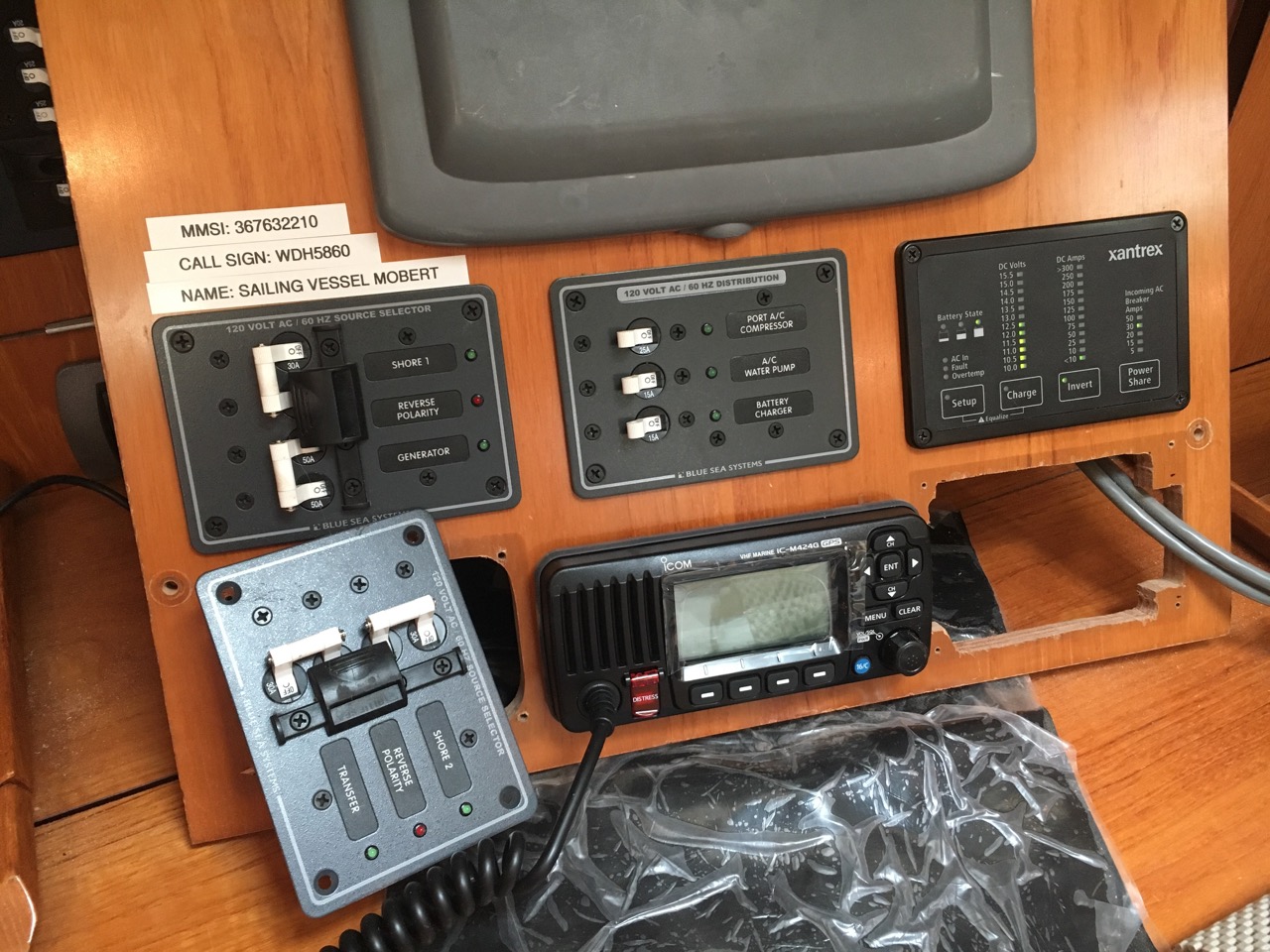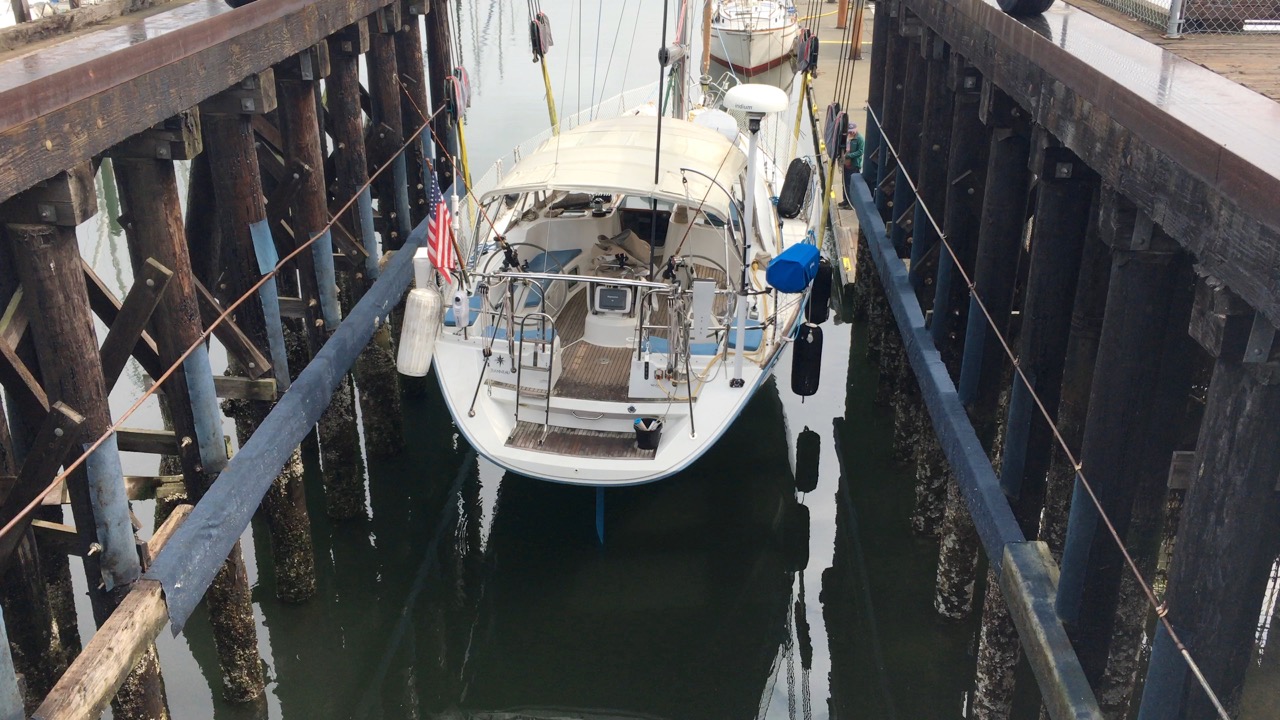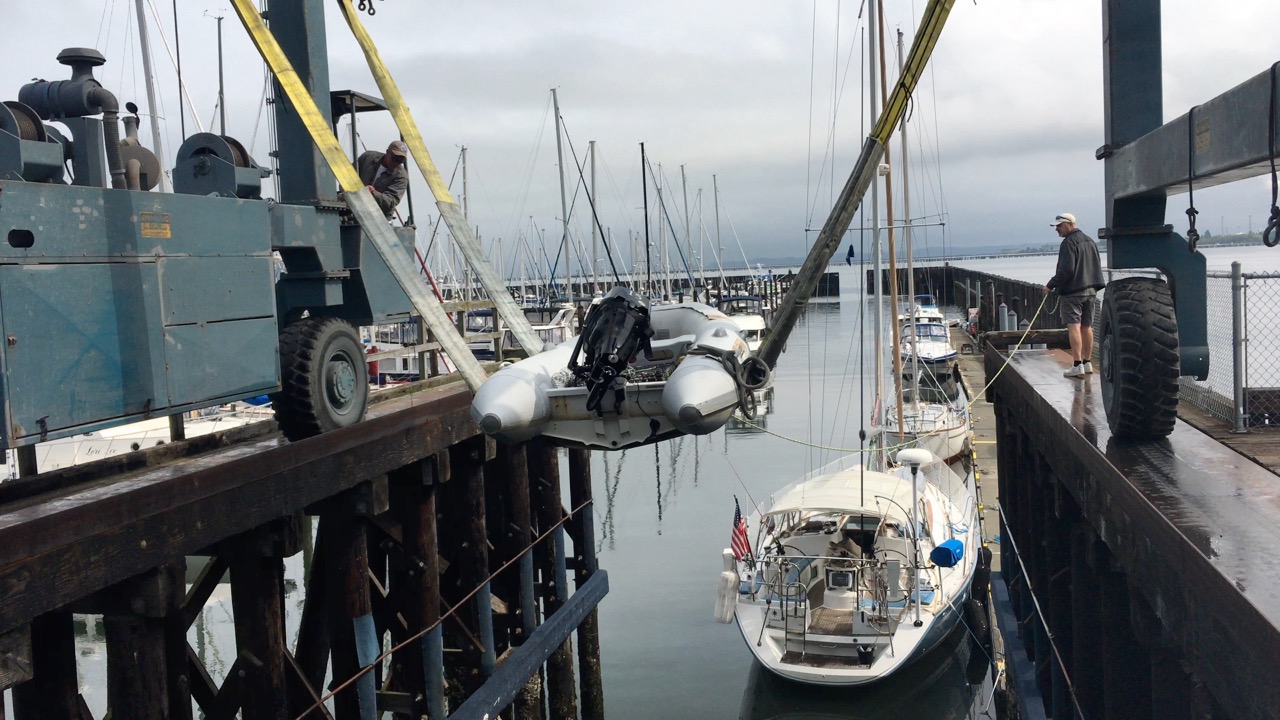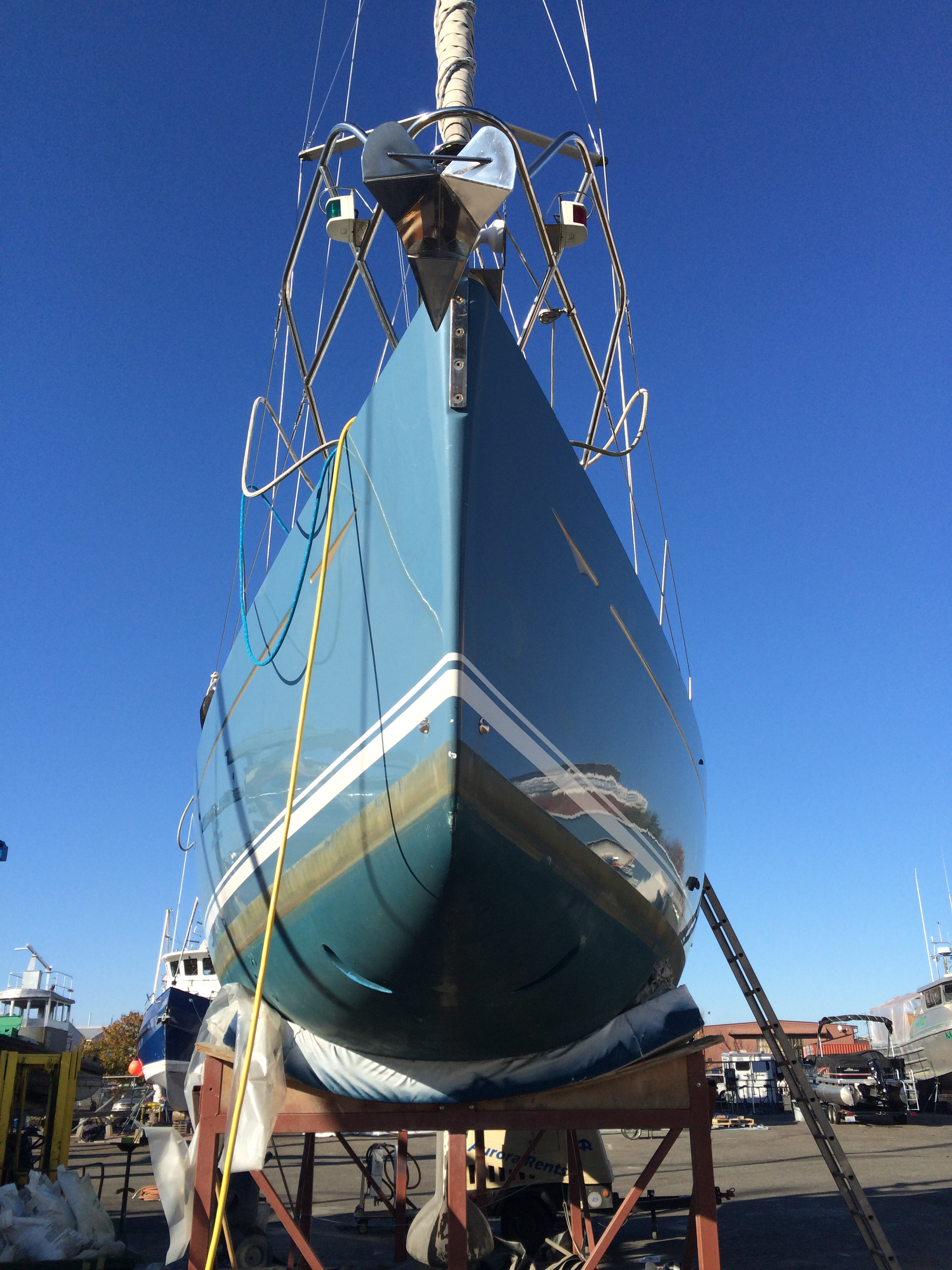Prepping For Offshore Sailing
(September 2nd-9th, 2017)
Before we left Anacortes for our vacation with family, we had to figure out what to do about our prop and keel. On our way north two months prior, we hit a log, and we weren’t sure how the prop fared. A few weeks later, our keel gave the rocky bottom a love bump, and we didn’t know if the rocks took off the keel’s epoxy, allowing the keel bulb to begin rusting. We had to get these questions sorted before heading offshore to California.
In my never-ending efforts to save money, I tried to dive on our prop and keel during our trip south, but failed. Rich even tried with the waterpoof Virb, but the water was too murky. So, we’d planned a haul-out in Anacortes to check our ride’s undercarriage. After much discussion, though, we figured a diver would be cheaper. We hadn’t had a chance to book the diver by the time we left the boat for our Labor Day Weekend visit with family. On our drive from the boat for that visit, we stopped at Marine Servicenter to give Jim, the owner, back some items we’d borrowed from him during Sail Alaska. As it turned out, the haul-out at Marine Servicenter was going to be cheaper than the diver – nice! But, we were leaving the boat at the marina and couldn’t get it to the yard. Jim, always customer-focused, said no problem – just leave the key and he’d bring the boat around from the marina. That would save us a few days’ marina fees in the process. It was a win-win-win for us.
So, we headed off to our Labor Day vacation knowing the boat was in good hands. It would get hauled out on Tuesday, and Jim would be in touch with photos and report on the prop and keel.
Meanwhile, we had to figure out how to reinforce the aft rail that the dinghy davits hung on. All during our Alaska trip, we watched the back rail pull back each time the dinghy swung on its davits in sizable seas. We couldn’t take it offshore with the dinghy on the davits in that state. So, we either had to reinforce the entire rail so that it could support the davits in big seas, or carry the dinghy on the bow. After a lot of consideration, Rich and I decided to reinforce the aft rail so we could keep the bow free in case we needed to go up there, and also to keep our sightline clear.

The problem was, the davit reinforcement kit Rich planned to install wasn’t going to arrive before we left. But once again, it was Marine Servicenter to the rescue – for not much more than we were planning to pay for the kit that Rich would install himself, and which would take up valuable space on our fabulous swim step, Marine Servicenter’s welder was going to install a custom support system.
The result of Marine Servicenter’s work was fantastic – not only did they get the job done in the short, three-day window we had to work with and on zero notice, but just as important, the support system was exactly what we’d dreamed of. The welder mounted the system to the sides of the transom, rather than the swim step, which was huge for us – crowding the swim step was one of the big reasons we had hesitated on the support system in the first place. More importantly, we could now hang on our davits without the back rail moving a millimeter. Our new davit support system was better and stronger than what we’d planned – one boat project was successful.

The keel problem also resolved well, and turned out to be a non-issue. It appears that the rock we thought we’d hit was actually a gravel bottom, and although it took some of our bottom paint off, the epoxy was unscathed. Marine Servicenter patched our bottom paint to give the hull protection until we do a full bottom paint job in Mexico.

The real problem turned out to be the prop. We don’t know if it was icebergs, or steel cables, but it certainly wasn’t a log. Whatever it was, those blades weren’t bent – they were chewed up.

On Wednesday, Rich and my dad made the drive to Anacortes to troubleshoot the prop and the aft rail support (which at that time was unresolved, and it was during that trip that Rich spoke with the welder to solve the rail problem). We weren’t comfortable heading offshore with the prop in the condition that it was, so with the aft rail and keel problems solved, Rich and my dad drove almost an hour to PYI, the local Max-Prop shop. We had a fixed prop we could install as a backup – it was the boat’s original prop – but Rich and my dad were extremely hesitant to use that prop down the coast. They believed the fixed prop would either spin in neutral making an annoying noise for days on end, or stay fixed in reverse, and we’d lose a knot of boat speed.
So, after driving over an hour to the yard in Anacortes, Rich and my dad took the prop another hour to PYI to see what our options were to fix it. We were hoping they could do a rebuild in a day, even though their turnaround on a rebuild was one week (and about $1,000). Unfortunately, a one-day turnaround on the rebuild wasn’t a possibility. So, the options were: 1) get the prop fully rebuilt which would take a week, and either delay the trip or require us to use the fixed prop for our run down ($1,000 + delay option); 2) buy a new Max-Prop from PYI and keep the old one as a spare, (two identical props rather than having the old fixed prop as a spare) (about $4,000); or 3) do a quick clean-up on the biggest issue (the prop wasn’t feathering correctly due to damage to the gears inside) and then plan to do a full rebuild later when we had more time ($120 option, which would still require us to spend $1,000 on the full rebuild later).
Rich and my dad pressed for us to buy a new prop, and leave the old one there to get rebuilt as our spare. I didn’t understand this option, because we already had a spare prop – the one the boat came with. Sure, a spare Max-Prop would be nice, but at a total of $5,000 for the $4,000 new prop plus the $1,000 rebuild on the old one, when we already had a spare prop on board, just didn’t compute. So, option 3 was the winner this time, at 10% of the cost of a full rebuild and 1 hour of time, instead of the 7-8 days required for a rebuild. We decided it was better to have the slightly chewed feathering propellor than wait a week or put the spare on. After Rich and my dad had lunch, they picked up the prop, which was shimmed, deburred, and properly feathering, with the chewed up spots ground down smoother. Then they went back to Anacortes to get the prop to Marine Servicenter to be re-installed, greased, and have anti-fouling added.

That was all on Wednesday. The next day, Thursday, Rich spent the day in Anacortes installing our new VHF. As you may recall, during our trip to Alaska, both the VHF and the cockpit mic buggered out. We managed to finish out the Alaska trip with the handheld, but for offshore and coastal passage-making, a new VHF was in order. And of course, despite the fact that we searched for a new ICOM that would have the same mounts and wires as our old one, no such thing existed, so the project required more cutting, drilling, and wire-pulling than should have been necessary. In the end, though, our new ICOM VHF radio was installed and working great just in time.

Despite the fact that we’d planned to be at the boat and load on Thursday – which would give us all day Friday to do last-minute projects and rest up – she wasn’t quite done in the yard, so on Thursday evening we spent another night with my parents in Snohomish. I had spent that day doing laundry, including all the bedding and towels on the boat – pretty much washing anything I could.
Thursday we drove up to Anacortes with all of our stuff to start loading. When we arrived they were ready to drop the boat in the water, which went smoothly as expected.

Since the dinghy was not on the davits (due to the welding work) she got a Travelift ride as well.

Back in the water we had several projects to get done before departure. Rich changed the oil on the engine since it had acquired more than enough hours during our trip to Alaska. We also added additional foot blocks near the job sheet winches to direct the spinnaker sheets since the lifeline netting forced us to change how we routed the sheets through the boat. We loaded all the food, refueled, filled the water tanks, changed the water filter on the watermaker, set up the beds, then headed to bed, ready for our early morning departure on Saturday the 9th.




